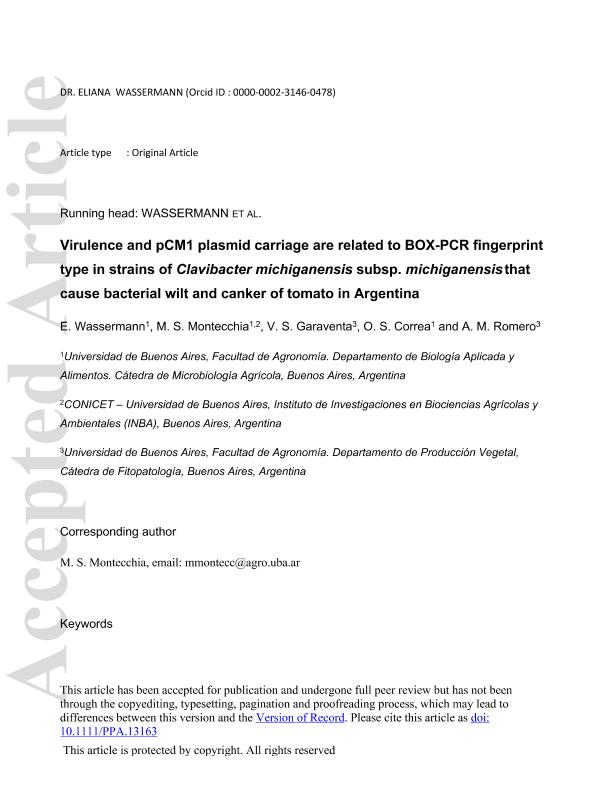Mostrar el registro sencillo del ítem
dc.contributor.author
Wassermann, Eliana

dc.contributor.author
Montecchia, Marcela Susana

dc.contributor.author
Garaventa, Valeria Soledad

dc.contributor.author
Correa, Olga Susana

dc.contributor.author
Romero, Ana María

dc.date.available
2021-11-12T15:16:59Z
dc.date.issued
2020-02
dc.identifier.citation
Wassermann, Eliana; Montecchia, Marcela Susana; Garaventa, Valeria Soledad; Correa, Olga Susana; Romero, Ana María; Virulence and pCM1 plasmid carriage are related to BOX-PCR fingerprint type in strains of Clavibacter michiganensis subsp. michiganensis that cause bacterial wilt and canker of tomato in Argentina; Wiley Blackwell Publishing, Inc; Plant Pathology; 69; 4; 2-2020; 723-732
dc.identifier.issn
0032-0862
dc.identifier.uri
http://hdl.handle.net/11336/146782
dc.description.abstract
Clavibacter michiganensis subsp. michiganensis (Cmm) causes bacterial wilt and canker in tomato, producing important economic losses worldwide. Its virulence has been related to several putative virulence factors present on a chromosomal pathogenicity island and on plasmids pCM1 and pCM2, in strain NCPPB382. We genotypically characterized a collection of Cmm isolates from the main greenhouse tomato-producing areas of Argentina by BOX-PCR fingerprinting and screened for the presence of genes and plasmids involved in pathogenicity by PCR. In addition, we evaluated in vitro cellulolytic activity and virulence in planta of selected strains. BOX-PCR fingerprinting clustered strains into four groups. Group II was dominant and included the most virulent strains, while Group III was the smallest and had the least virulent strains. All local strains exhibited similar cellulolytic activity. Most of the examined strains carry two plasmids of similar size to those of NCPPB382, although there were strains with one or three plasmids. By PCR amplification of repA, pCM1 was detected only in strains belonging to Group III, which includes local strains closely related to reference strain NCPPB382. All analysed pathogenicity genes were widespread among strains, and so in strains belonging to Groups I and II, celA found on pCM1 in NCPPB382 could be found in the chromosome or in plasmids other than pCM1. This study contributes to a better understanding of the diversity of Cmm genetic profiles and virulence of strains present in Argentina. Such information could be useful for the selection of strains for screening of host resistance and development of resistant tomato varieties.
dc.format
application/pdf
dc.language.iso
eng
dc.publisher
Wiley Blackwell Publishing, Inc

dc.rights
info:eu-repo/semantics/openAccess
dc.rights.uri
https://creativecommons.org/licenses/by-nc-sa/2.5/ar/
dc.subject
CELLULOLYTIC ACTIVITY
dc.subject
CLAVIBACTER MICHIGANENSIS SUBSP. MICHIGANENSIS
dc.subject
PATHOGENICITY GENES
dc.subject
POPULATION DIVERSITY
dc.subject
SOLANUM LYCOPERSICUM
dc.subject.classification
Agricultura

dc.subject.classification
Agricultura, Silvicultura y Pesca

dc.subject.classification
CIENCIAS AGRÍCOLAS

dc.title
Virulence and pCM1 plasmid carriage are related to BOX-PCR fingerprint type in strains of Clavibacter michiganensis subsp. michiganensis that cause bacterial wilt and canker of tomato in Argentina
dc.type
info:eu-repo/semantics/article
dc.type
info:ar-repo/semantics/artículo
dc.type
info:eu-repo/semantics/publishedVersion
dc.date.updated
2021-09-07T15:13:56Z
dc.journal.volume
69
dc.journal.number
4
dc.journal.pagination
723-732
dc.journal.pais
Reino Unido

dc.journal.ciudad
Londres
dc.description.fil
Fil: Wassermann, Eliana. Universidad de Buenos Aires. Facultad de Agronomía. Departamento de Biología Aplicada y Alimentos. Cátedra de Microbiología Agrícola; Argentina. Consejo Nacional de Investigaciones Científicas y Técnicas; Argentina
dc.description.fil
Fil: Montecchia, Marcela Susana. Consejo Nacional de Investigaciones Científicas y Técnicas. Oficina de Coordinación Administrativa Parque Centenario. Instituto de Investigaciones en Biociencias Agrícolas y Ambientales. Universidad de Buenos Aires. Facultad de Agronomía. Instituto de Investigaciones en Biociencias Agrícolas y Ambientales; Argentina. Universidad de Buenos Aires. Facultad de Agronomía. Departamento de Biología Aplicada y Alimentos. Cátedra de Microbiología Agrícola; Argentina
dc.description.fil
Fil: Garaventa, Valeria Soledad. Universidad de Buenos Aires. Facultad de Agronomía. Departamento de Producción Vegetal. Cátedra de Fitopatología; Argentina
dc.description.fil
Fil: Correa, Olga Susana. Universidad de Buenos Aires. Facultad de Agronomía. Departamento de Biología Aplicada y Alimentos. Cátedra de Microbiología Agrícola; Argentina
dc.description.fil
Fil: Romero, Ana María. Universidad de Buenos Aires. Facultad de Agronomía. Departamento de Producción Vegetal. Cátedra de Fitopatología; Argentina
dc.journal.title
Plant Pathology

dc.relation.alternativeid
info:eu-repo/semantics/altIdentifier/doi/https://doi.org/10.1111/ppa.13163
dc.relation.alternativeid
info:eu-repo/semantics/altIdentifier/url/https://bsppjournals.onlinelibrary.wiley.com/doi/10.1111/ppa.13163
Archivos asociados
